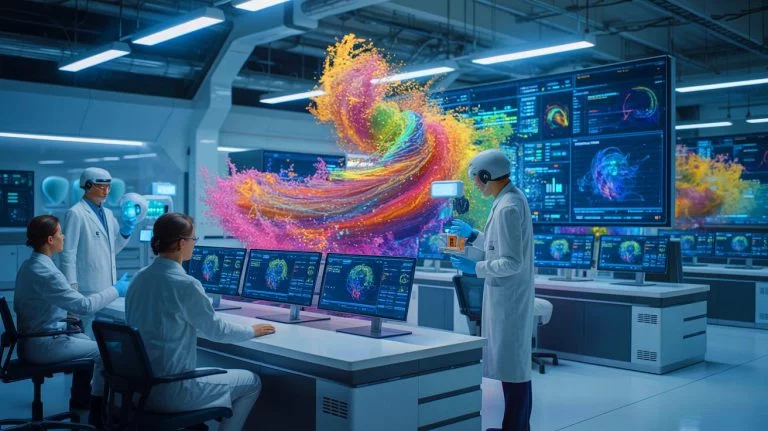| IN A NUTSHELL |
|
A groundbreaking study at Emory University has harnessed artificial intelligence (AI) to uncover new forces in the realm of dusty plasma. This research challenges long-held assumptions in plasma physics and demonstrates the potential for AI to discover novel physical laws. By training a neural network with experimental data from dusty plasma, researchers have provided new insights into particle interactions, offering a glimpse into how AI can revolutionize our understanding of complex systems.
Unveiling the Mysteries of Dusty Plasma
Dusty plasma, a hot, electrically charged gas filled with tiny dust particles, is present throughout the universe. From the rings of Saturn to smoke from wildfires on Earth, this state of matter is pervasive yet poorly understood. Traditionally, scientists have faced challenges in deciphering the forces at play within dusty plasma due to its non-reciprocal nature. This means that the force exerted by one particle on another is not necessarily reciprocated, complicating analyses.
Emory University researchers took an innovative approach by using AI to tackle this problem. They constructed a sophisticated 3D imaging system to track the movement of plastic dust particles within a plasma-filled chamber. By employing a laser sheet and high-speed camera, they captured the intricate trajectories of these particles over time. This data served as the foundation for training a custom neural network to discern complex interactions within the dusty plasma.
The AI model’s groundbreaking ability to describe non-reciprocal forces with over 99% accuracy highlights its potential to unlock new realms of scientific discovery. Notably, the AI revealed that when one particle leads, it pulls the trailing one closer, while the trailing particle exerts a push away. This asymmetric interaction, previously theorized but never clearly modeled, underscores the AI’s capability to enhance our understanding of particle dynamics.
AI’s Role in Correcting Plasma Physics Assumptions
The AI system also corrected several misconceptions that have shaped plasma theory for years. For instance, a long-held assumption posited that a particle’s electric charge increased proportionally with its size. However, the AI demonstrated that this relationship is actually influenced by the surrounding plasma’s density and temperature.
Moreover, another assumption suggested that the force between particles decreased exponentially with distance, irrespective of particle size. The AI revealed that this drop-off is also contingent on particle size, offering a nuanced understanding of particle interactions. This revelation not only refines theoretical models but also paves the way for the application of AI in studying many-particle systems.
The AI’s ability to operate on a desktop computer and produce a universal framework applicable to diverse systems, from industrial materials to biological cells, illustrates its transformative potential. This study exemplifies AI’s capacity to transcend traditional data processing roles and contribute to scientific advancements by uncovering the hidden rules governing nature.
Implications for Future Scientific Exploration
By demonstrating AI’s potential to discover new physics, the Emory University study sets a precedent for future research endeavors. The framework developed through this study has the potential to revolutionize our understanding of complex systems, offering insights into everything from paint mixtures to cellular behavior in living organisms.
As AI continues to evolve, its application in scientific research could lead to breakthroughs across multiple disciplines. The ability to model and predict complex interactions with high accuracy opens new avenues for exploration, potentially leading to innovations in material science, biology, and beyond.
This study also emphasizes the importance of integrating AI with traditional scientific methods. By leveraging AI’s analytical capabilities alongside experimental data, researchers can unlock new understandings and challenge existing paradigms. The success of this project underscores AI’s role as a powerful tool for scientific discovery, encouraging further exploration and application in diverse fields.
The Future of AI in Scientific Research
The success of the AI-driven research at Emory University highlights the vast potential for AI to revolutionize scientific exploration. By providing a framework for understanding complex systems, AI offers an opportunity to challenge existing assumptions and uncover new laws of nature. As AI technology advances, its integration into scientific research is likely to become more prevalent, driving innovation and expanding the boundaries of what is possible.
This study serves as a testament to the transformative power of AI in scientific discovery. By bridging the gap between traditional research methods and AI-driven analysis, scientists can gain new insights into the natural world. As researchers continue to explore the capabilities of AI, the potential for groundbreaking discoveries remains vast and largely untapped.
Given the success of this study, what other areas of scientific research might benefit from the application of AI, and how can researchers further harness AI’s potential to uncover new insights into the universe?
Did you like it? 4.5/5 (24)








Wow, AI can do that? 🧠 Science fiction is becoming reality!
Can this AI model be applied to other types of plasma, like those in nuclear reactors?
I’m amazed by how AI is revolutionizing everything, even dusty plasmas! 🤖
Seems like AI is the new Einstein of our times.
How do they ensure the AI model is accurate? Could there be any biases in the data?